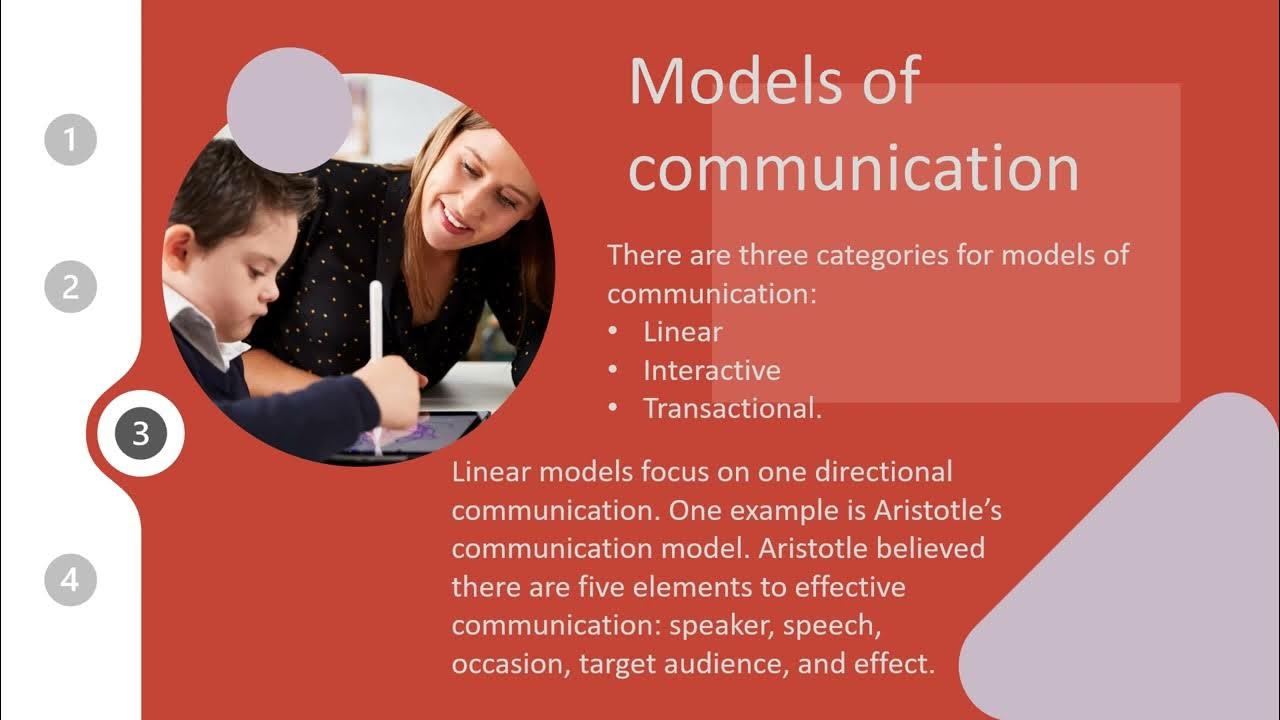Communication Models
Summary
TLDRThis script explores three primary models of communication: the transmission model, which views communication as a linear process with potential interference; the transactional model, emphasizing interactive meaning-making and feedback; and the constitutive model, which posits that communication actively creates our social reality. The summary highlights the evolution from a one-way message delivery to a dynamic, reciprocal interaction that shapes our understanding of communication.
Takeaways
- 📚 The script discusses three main models of communication: the transmission model, the transactional model, and the constitutive model.
- 📘 The transmission model, introduced by Shannon & Weaver in 1948, views communication as a linear process with a sender, message, channel, receiver, and potential noise interference.
- 🏹 The transmission model is likened to an archer, where the message is sent without certainty of hitting the target, emphasizing the lack of feedback in this model.
- 🔍 This model is criticized for not accounting for nonverbal communication and the complexities of human interaction.
- 🤝 The transactional model, developed by Watzlawick and others in the late 1960s, sees communication as an interactive process where meaning is created through interaction between senders and receivers.
- 💬 The transactional model includes nonverbal communication and feedback, emphasizing that communication is an ongoing, two-way process.
- 🎭 The 'dance' metaphor is used to describe the transactional model, highlighting the dynamic and simultaneous nature of communication.
- 🌐 The constitutive model, proposed by Robert Craig in 1999, posits that communication is not just about conveying information but is the driving force that creates our social world.
- 🏗️ According to the constitutive model, communication is the primary social process that shapes our society, relationships, and lives.
- 🔑 The script suggests that understanding these models helps in interpreting communication research and readings.
- 🔄 Each model offers a different perspective on communication, with the transactional and constitutive models addressing the shortcomings of the transmission model.
Q & A
What are the three main models of communication discussed in the script?
-The three main models of communication discussed are the transmission model, the transactional model, and the constitutive model.
Who developed the transmission model of communication and in what year?
-The transmission model was developed by Shannon & Weaver in 1948.
What is the technological angle in the transmission model of communication?
-The technological angle in the transmission model is that it envisions a sender who encodes a message and transmits it through a channel, similar to the phone system.
What is the role of 'noise' in the transmission model of communication?
-In the transmission model, 'noise' can interfere with the message at any point along the way, potentially causing the message to be garbled or not make sense when received.
How does the transmission model view the occurrence of communication?
-According to the transmission model, communication has successfully occurred when a message has been sent and received, regardless of whether the receiver understood the message.
What is a major weakness of the transmission model in terms of face-to-face communication?
-A major weakness of the transmission model is the lack of feedback and nonverbal communication, which does not capture the complexities of face-to-face interactions.
Who are the key contributors to the transactional model of communication and when were their contributions made?
-Paul Watzlawick and his colleagues in 1967, and Dean Barnlund in 1970, contributed to the development of the transactional model of communication.
How does the transactional model differ from the transmission model in terms of meaning creation?
-The transactional model believes that meaning is created through interaction between people, not contained in the words themselves.
What is the significance of the phrase 'You cannot not communicate' in the transactional model?
-The phrase signifies that individuals are always sending messages, whether intentionally or unintentionally, including through nonverbal communication and feedback.
What is the constitutive model's view on the role of communication in society?
-The constitutive model sees communication as the primary social process that creates and constitutes society, relationships, and our lives.
Who proposed the constitutive theory of communication and what did they emphasize?
-Robert Craig proposed the constitutive theory in 1999, emphasizing that communication is not just a tool but the central activity that creates social reality.
How does the constitutive model relate to the idea of 'organizing' as opposed to 'organization'?
-The constitutive model aligns with the idea of 'organizing' as it views communication as an ongoing activity that creates and maintains social structures, rather than a static term like 'organization'.
Outlines

This section is available to paid users only. Please upgrade to access this part.
Upgrade NowMindmap

This section is available to paid users only. Please upgrade to access this part.
Upgrade NowKeywords

This section is available to paid users only. Please upgrade to access this part.
Upgrade NowHighlights

This section is available to paid users only. Please upgrade to access this part.
Upgrade NowTranscripts

This section is available to paid users only. Please upgrade to access this part.
Upgrade Now5.0 / 5 (0 votes)





